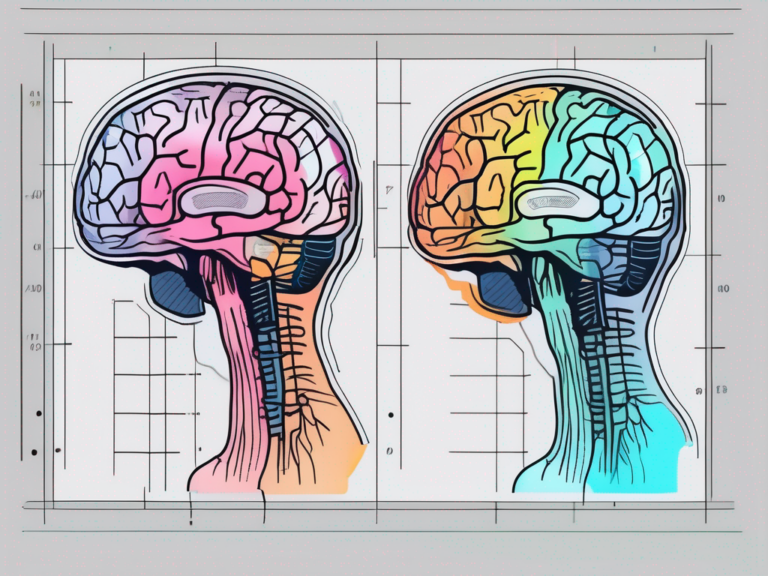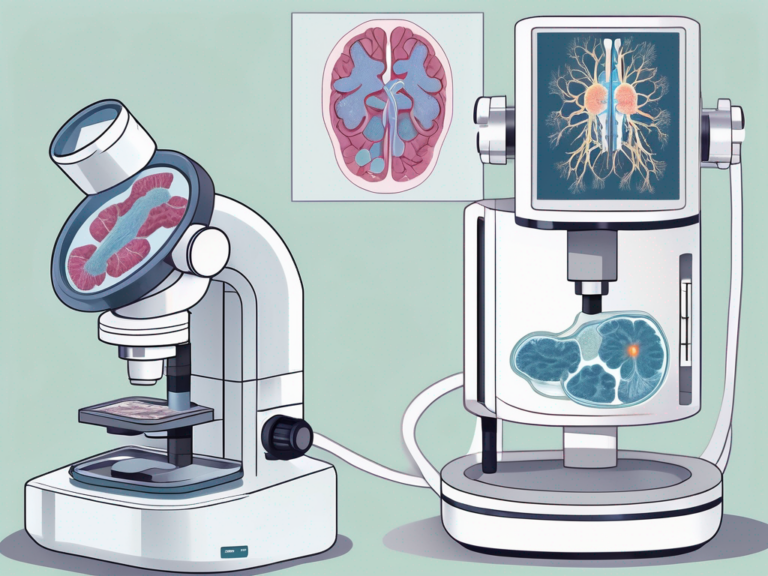how does fmri measure brain activity
In the world of neuroscience, functional magnetic resonance imaging (fMRI) stands out as a powerful tool for understanding brain activity. By capturing images that reveal the subtle changes in blood flow and oxygen levels in the brain, this technology offers researchers and physicians valuable insights into the inner workings of the human mind. In this article, we will take a deep dive into the world of fMRI, exploring its basics, the process of measurement, how to interpret its results, its applications and limitations, as well as the exciting future of brain imaging.
Understanding the Basics of fMRI
What is fMRI?
Functional magnetic resonance imaging (fMRI) is a non-invasive imaging technique that allows researchers and clinicians to visualize and analyze brain activity in real-time. With the help of powerful magnetic fields and radio waves, fMRI reveals the regions of the brain that are active during various cognitive tasks or in response to stimuli.
One of the key advantages of fMRI is its ability to provide detailed spatial information about brain activity, allowing researchers to map out specific brain regions involved in different functions such as language processing, memory retrieval, and motor coordination. This spatial resolution is crucial for understanding the complex network of connections within the brain and how different regions work together to produce various behaviors and cognitive processes.
The Science Behind fMRI
The basic principle of fMRI lies in the relationship between blood flow, oxygen levels, and neural activity. When a particular brain region becomes active, it requires more oxygen and nutrients to sustain heightened activity. In response, the blood vessels in that region dilate, leading to an increased blood flow to meet the increased demand. By measuring the changes in blood oxygen level-dependent (BOLD) signals, fMRI can pinpoint the precise areas of the brain involved in specific mental processes.
Furthermore, fMRI can also be used to study brain connectivity by analyzing how different brain regions communicate with each other during various tasks or at rest. This approach, known as functional connectivity analysis, provides valuable insights into the coordinated activity of brain networks and how disruptions in connectivity may be associated with neurological or psychiatric disorders. By combining information about both brain activation and connectivity patterns, researchers can gain a more comprehensive understanding of brain function and dysfunction.
The Process of Measuring Brain Activity with fMRI
Preparing for an fMRI Scan
Before an fMRI scan, participants are usually given instructions and vital information to ensure a smooth and successful procedure. They might be asked to remove any metallic objects, such as jewelry or accessories, that can interfere with the magnetic fields. Additionally, participants need to lie still in the scanner for an extended period, so they are typically provided with earplugs or headphones to minimize scanner noise and enhance comfort.
Furthermore, prior to entering the fMRI suite, participants are often screened for any contraindications that may prevent them from safely undergoing the scan. This screening process typically involves checking for any metal implants, pacemakers, or other devices that could be affected by the strong magnetic field of the scanner. Ensuring the safety of participants is paramount in the fMRI scanning process.
The Role of Magnetic Fields and Radio Waves
Once the participant is prepared, the fMRI scanner utilizes a strong magnetic field and radio waves to capture images of the brain. The powerful magnet aligns the hydrogen atoms in the body, while the radio waves are used to disturb this alignment temporarily. As the atoms return to their original alignment, they emit signals that are detected by the scanner and processed to create brain images.
Moreover, the fMRI machine’s magnetic field is so powerful that it can cause the protons in the body to align with it, creating a uniform magnetic field within the body. This alignment is crucial for the accurate detection of brain activity. The radio waves, on the other hand, are carefully controlled and targeted to specific areas of the brain to elicit responses that can be measured and analyzed to map out brain functions.
Interpreting fMRI Results
Understanding fMRI Images
Interpreting fMRI images requires a deep understanding of brain anatomy and function. The images produced by fMRI consist of a series of slices that represent brain activity. Areas of increased activity are typically shown as brighter or colored regions, indicating the brain regions involved in the particular task or condition being studied.
It is important to consider that fMRI images are not direct pictures of brain activity but rather indirect measurements based on changes in blood flow and oxygen levels. These changes are inferred to reflect neural activity in specific brain regions. Researchers use advanced statistical methods to analyze these complex data and draw meaningful conclusions about brain function.
The Significance of Color in fMRI Scans
While color plays a crucial role in fMRI scans, it is essential to note that the colors in these images are not arbitrary or directly representative of brain activity intensity. Instead, various color maps are used to aid visualization and emphasize differences in brain activity between regions. The selection of color maps is carefully considered to provide meaningful representations of brain activity patterns.
Color coding in fMRI images serves as a visual aid to help researchers and clinicians identify patterns of brain activation more efficiently. By assigning different colors to varying levels of brain activity, it becomes easier to differentiate between regions of high and low activity. This color enhancement technique enhances the interpretability of fMRI results and facilitates the communication of findings to a wider audience.
Applications and Limitations of fMRI
Uses of fMRI in Neuroscience and Medicine
fMRI has revolutionized our understanding of brain function and its role in cognition, emotion, language, perception, and various neurological and psychiatric disorders. It has helped researchers unravel the mysteries of the brain and contributed to the development and refinement of neurological treatments and interventions.
One fascinating application of fMRI is its use in studying the effects of mindfulness and meditation on the brain. Researchers have employed fMRI to observe changes in brain activity associated with mindfulness practices, shedding light on the neural mechanisms underlying stress reduction and emotional regulation. This research has provided valuable insights into how mindfulness can alter brain function and structure, offering new avenues for therapeutic interventions.
Potential Drawbacks and Limitations of fMRI
While fMRI is an incredibly valuable tool, it does have its limitations. The technology is expensive, and the interpretation of fMRI results requires expertise and specialized training. Additionally, fMRI only captures indirect measures of brain activity and does not provide a direct window into individual neurons’ firing patterns. Understanding and accounting for these limitations is crucial for accurately interpreting fMRI data.
Another limitation of fMRI is its reliance on blood oxygen level-dependent (BOLD) signals, which can be influenced by factors such as motion artifacts, physiological noise, and individual variability in vascular responses. These confounding factors can complicate data analysis and interpretation, highlighting the importance of rigorous quality control measures in fMRI studies. Researchers continue to develop innovative techniques to address these challenges and improve the reliability and validity of fMRI findings.
The Future of fMRI and Brain Imaging
Technological Advances in fMRI
The field of fMRI continues to evolve rapidly, with ongoing advancements in technology. Scientists are exploring new methods to enhance spatial and temporal resolution, allowing for more precise mapping of brain regions and a deeper understanding of the complex dynamics of neural networks. Innovations such as ultra-high-field scanners, multi-modal imaging techniques, and advanced data analysis algorithms promise exciting breakthroughs in the future.
One area of technological advancement in fMRI is the development of ultra-high-field scanners. These scanners operate at higher magnetic field strengths, enabling researchers to capture more detailed images of the brain. With increased spatial resolution, scientists can now visualize smaller brain structures and detect subtle changes in neural activity. This opens up new possibilities for studying the intricate connections between different regions of the brain and unraveling the complexities of cognitive processes.
In addition to improved scanners, researchers are also exploring multi-modal imaging techniques. By combining fMRI with other imaging modalities such as EEG (electroencephalography) or MEG (magnetoencephalography), scientists can obtain a more comprehensive picture of brain activity. This integration of different imaging modalities allows for a more accurate and detailed understanding of the underlying neural mechanisms, providing insights into how different brain regions interact and contribute to various cognitive functions.
Ethical Considerations in Brain Imaging
As fMRI and other brain imaging technologies continue to advance, it is crucial to consider the ethical implications of their use. Questions of privacy, informed consent, and potential misuse arise in fields such as lie detection and mind-reading. Ongoing discussions and collaborations among scientists, policymakers, and ethicists are essential in shaping guidelines and creating a responsible framework for the use of fMRI and related technologies.
Privacy concerns are a significant ethical consideration in the context of brain imaging. As fMRI technology becomes more sophisticated, it raises concerns about the potential invasion of individuals’ privacy. The ability to decode thoughts and emotions from brain activity raises questions about the boundaries between personal thoughts and public knowledge. Striking a balance between scientific progress and protecting individuals’ privacy is a complex challenge that requires careful consideration and regulation.
Another ethical consideration is the issue of informed consent. Participants in fMRI studies need to understand the nature of the research and the potential risks and benefits involved. Ensuring that participants are fully informed and have the autonomy to make decisions about their participation is crucial for maintaining ethical standards in brain imaging research. Additionally, researchers must consider the potential impact of the findings on participants’ well-being and mental health, taking appropriate measures to minimize any potential harm.
In conclusion, fMRI has revolutionized the way we study and understand brain activity. By harnessing the power of magnetic fields and radio waves, fMRI provides invaluable insights into the inner workings of the human mind. From its basics and the process of measurement, to interpreting its results and exploring its applications and limitations, fMRI continues to push the boundaries of neuroscience. The future of brain imaging looks promising, with technological advances on the horizon and ongoing ethical considerations shaping responsible practices. As we delve deeper into the complexities of the brain, fMRI remains an indispensable tool in unraveling the mysteries of the mind.






